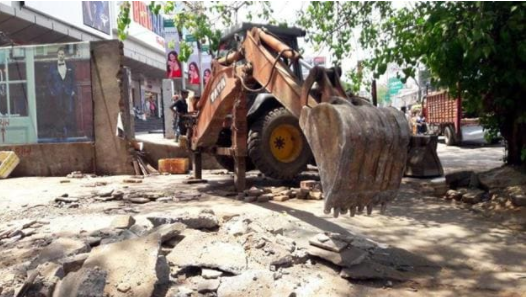In Jharkhand, Admin Turns Ecology Drive on Head, Evicts Poor from Homes

Image Courtesy: Hindustan Times
On the morning of 22 July, Kanke and Argora block residents in Ranchi were stunned to see police vehicles approach their area. Things became clear when they saw the bulldozers and JCBs coming. On the directions of the Jharkhand High Court, the Municipal Corporation was here to clear encroachments in the Mission Gali and Raja Bagan areas next to the Kanke Dam.
The High Court has ruled hat all constructions within 15 meters of water bodies would be demolished under the Jharkhand Public Land Encroachment Act, 2000. The administration was determined to demolish (on two days notice) at least thirty-four such houses in the Kanke block.
The residents resisted, though not violently, going by videos of the demolition that circulated on social media. Around 15 houses were turned to rubble when a resident, Pushpa Devi, fell unconscious. Then the situation turned volatile. Pushpa’s husband is an auto driver, and they had saved every penny to build their home.
In one video, resident Babita Devi points at double and triple-storey concrete houses next door and says, “Only the shelters of the poor get destroyed.” Many residents in the area reportedly possess registry and mortgage documents, as well as electrical connections. The situation is grim in the area.
Nine homes near the Hinoo river also got demolished in the Argora locality. This drive has made residents of catchment areas wary--as if expecting teams from the municipality and administration to swoop on them any time.
On 23 July, the administration identified three more spots along the Hinoo river in Argora block--Patratoli, Kilburn colony and Shukla colony. Many houses in Patratoli are in the catchment of the Dhurwa Dam. Its residents, mostly Adivasis, had geared up to fight the demolitions. They waited for the demolition team at the Patratoli bridge during a heavy spell of rain, holding placards declaring the previous circle officer’s report as incorrect.
“We gave all our land to construct the dam and Ring Road. If they demolish what we have left, where will we go? Where will we make our houses?” says an agitating woman. They got hardly a 12-hour notice and no provision for resettlement despite the monsoon and the pandemic. Their homes got bulldozed.
The drives at Kilburn and Shukla Colony were unsuccessful as bulldozers could not pass through the narrow lanes. Strangely, the administration has asked residents of these areas to demolish their own homes or else the administration would.
Ranchi Deputy Commissioner Chhavi Ranjan said on 22 July that the administration is surveying all water bodies to identify houses to bring down. So far, it has found 200 homes along the Hinoo, Kanke Dam and Bada Talab (a.k.a. Swami Vivekananda Sarovar. Another 25 homes are in the Getalsuld Dam area. In all, 500 houses may get demolished once the survey is complete. A considerable number of these houses belong to members of marginalised communities. For example, near the Getalsuld Dam, all the houses are of the Adivasis and Dalits.
The demolition drive began with a petition filed by advocate Khusboo Kataruka. In a telephonic interview, she says, “The Court ordered the Ranchi Municipal Corporation to remove commercial buildings in the catchment area. But the RMC took action on houses of poor residents, who had been duped by land mafias and the administration. That too, without any resettlement provisions.”
On 26 July, the drive reached Getalsud Dam, where 25 “illegal structures” got demolished. Simultaneously, bulldozing continued at the Kanke Dam area. The campaign to break down the houses seems to be getting more frenzied.
Homes are conscious investments
It is forgotten during demolition drives that the administration and approval authorities allow homes to come up in catchment areas. There are only two possibilities: either the houses lack clearances, or a sluggish administration allowed the residents to secure electricity and water connections. Indeed, the Jharkhand High Court has criticised the lopsided state capital’s urban development of Ranchi. The documents the homeowners possess confirms the administrative lethargy.
Even now, the rich are having their way. The well-known Hotel Emerald in Ranchi has caught the administration’s eye, but no action has been taken on it or other large structures. The hotel is contesting the demolition legally. On 5 August, Municipal Commissioner Mukesh Kumar’s court rejected its plea. Yet it is not clear if the hotel will make it or not. If it does, it is sure to raise questions about discrimination against the underprivileged, who are already losing their homes.
The court case
A two-judge bench of the Jharkhand High Court led by Chief Justice Ravi Ranjan took suo moto cognisance of five writ petitions and a civil contempt case related to unauthorised constructions in Ranchi and around. Kataruka’s petition was on the deteriorating condition of the Swami Vivekanand Sarovar, known as Bada Talab, the oldest lake in the heart of Ranchi. The lake has been taken over by water hyacinth, which depletes oxygen availability and harms the aquatic ecosystem, including migratory birds.
Her appeals to the RMC and other administrative departments did not help, so she knocked on the court’s doors. The High court clubbed all petitions on water bodies and is still hearing the case. On 18 March, it ordered the Ranchi Municipal Corporation Commissioner, Mukesh Kumar, to compare the maps of 1928-1929 to those of the present day. On 25 March, the bench presented two water bodies as case studies.
The court said the encroachments alongside the river, in what earlier was a catchment area, are now occupied by multistoried buildings or boundary walls that demarcate plots of land. It exposes the administrative failures in planning.
Due to constructions along the Dhurwa Dam area, the court warned that dam water would enter the nearby hills, creating water shortages. On 15 July (the latest hearing), the principal secretary, Urban Development, Vinay Chaubey, confirmed the demolitions and promised an action report.
After the High Court called out the administration for laxity, it began an over-zealous anti-encroachment drive, perhaps not wishing to invite its anger.
Callous development
Ranchi is an ever-growing city. Its built-up area has increased significantly over the last century.

Graph 1: Orange lines show the areas of Ranchi built up after 1927.
The three principal dams of Ranchi, Dhurwa (built, 1962), Kanke (1954) and Getalsud, 1971, can support the water needs of four to five lakh residents. Census 2011 records the population of Ranchi at over ten lakhs. Even the construction of these dams caused considerable relocation and ecological damage. However, the administration has started demolitions without ever de-silting any of these dams since they got constructed.
The groundwater level is decreasing in Ranchi at an alarming rate. Ponds and small water bodies that work as natural recharge pits have reduced from over 100 in the 1970s to 42 at present.
A recent Groundwater Directorate survey says Ranchi’s water table declined by 8.94 metres between 2009 and 2014 due to overexploitation of groundwater. Unplanned town expansion is the main culprit. Indeed, the catchment area of these dams and lakes is decreasing rapidly. Some 23% of the area around Dhurwa Dam is encroached or covered by algae since maintenance and upkeep get ignored.
Human rights of the marginalised
Anti-encroachment drives in the name of ecological concerns are inhumane. The administration and even the judiciary have ignored the basic needs of the Adivasi population. It is doubly ironic since Jharkhand was carved out as a state to protect the interests of the Adivasis. Yet, the elites of Jharkhand, many of them non-tribal, have failed to find a systemic solution to problems posed by urban expansion. Instead, the most vulnerable sections pay for both the development process and the so-called clean-up.
The state built 84 dams in Jharkhand, on Adivasi land. Yet 49% of tribals in Jharkhand live below the poverty line. More than 80 lakh people have been displaced in the region since independence.
In a state overburdened with mining operations, it is unacceptable that there are also discrepancies in the online land banks or that a dubious map clearance process exists. The monsoon, accompanied by the pandemic, is the worst season for an "anti-encroachment" drive. The court should have been more reasonable about the demolition and ensured compensation for evicted families. City expansion is not unique to India. It is an expected and well-known phenomenon. Sustainability of the environment cannot justify evictions—we cannot purport to “save the environment” without justice and equity towards human beings.
The author is an independent journalist based in Jharkhand. The views are personal.
Get the latest reports & analysis with people's perspective on Protests, movements & deep analytical videos, discussions of the current affairs in your Telegram app. Subscribe to NewsClick's Telegram channel & get Real-Time updates on stories, as they get published on our website.
























